Did you know that you can place ads inside emails? You can place banner ads inside an email just like on a website.
Now, you might wonder if these ads are annoying readers because they have not signed up to receive email ads. According to a new research study performed by Mantis Research, more than 40% of surveyors said they were not bothered by ads in their emails.
Moreover, almost two out of three surveyors said they might even click on email ads if they find them interesting. So, as long as you place ads relevant to the readers, you'll get good results from email advertising.
We'll tell you what you need to do to start email advertising, different types of email advertising, and how to do it properly.
Table of contents
What is email advertising?
Email advertising is a paid advertising strategy where you can pay to place ads either inside an email like newsletters or in the inbox to reach targeted audiences outside your prevailing Customer Relationship Management (CRM) database.
If you are an email marketer, you can leverage this opportunity and " rent out " spaces inside your email to allow other brands to place advertisements in your email campaigns. You can opt to get paid for the ads you place in your email or form a mutually beneficial agreement with the brand you are advertising.
Advantages of email advertising
Not a lot of brands place ads in emails, and here are the advantages of advertising through emails or inboxes that you might be missing out on:
1. You can advertise to a targeted and engaged audience
Subscribers sign up for emails that they are interested in. So, suppose you advertise in emails from companies related to your niche. In that case, it's more likely that readers will click on your ads because they are already interested and have signed up to receive emails related to the topic.
However, it's more of a guessing game in other advertising platforms to determine if they would be interested in your product or service. So, you might not see good results from such advertisements compared to email advertisements.
2. You are not limited by IAB-sizing principles when placing ads in emails
The Interactive Advertising Bureau (IAB) has standard ad measurement units recommended for ads placed across apps, websites, and social media platforms. Fortunately, emails are not subjected to the IAB restrictions, so that you can create powerful and engaging ads with more flexibility in the email ad size.
3. You can collect first-party data
First-party data is the data you get directly from the audience, and it can be anything like an email address, action taken in the email, etc. With the help of first-party data, you can accurately identify your target audience, segment them, and target them with personalized ads.
"Email is one of the rare channels marketers can (and should) use to form a direct customer connection. It provides access to first-party data & engagement signals that tell you exactly what your audience cares about.
— Anna 👩🏾💻 Copywriting + Email Strategy (@annasarayna) June 2, 2022
Email is the first place we see if an audience is engaging." https://t.co/znxUHr5drW
4. You get more visibility in an email or inbox compared to other platforms
Emails like newsletters are usually not as dense or cluttered as other advertising means, allowing your email ads to stand out to your readers. And, if the ads are located near the email header or above the newsletter's footer, then it'll be more noticeable to readers.
Also, ads in the inbox are shown at the beginning, so you are guaranteed to have a lot of eyeballs seeing your ad.
Disadvantages of email advertising
Advertising in emails might seem glamorous so far, but there are a few disadvantages to email ads. Here they are:
1. Images in your email ads could get cached
When an email client, like Google, notices that the same image is being sent out to many people, like 10K readers, it caches it. Google would host the image on their server to speed up delivery.
You are probably wondering why this is a problem? Well, it is problematic because cached images prevent accurate impression reporting. It means that even if all 10K people see your ad, you would see only one impression, not 10K. Thus, caching makes impressions an unreliable metric for tracking your ad campaigns.
2. You are limited in terms of formatting of your email ads
Email ad serving only works with image-based creatives, which means that you won't be able to use JavaScript, iFrames, Flash, or other non-image-based creatives. It's a problem since it restricts the ads you can show. In addition, some Email Service Providers (ESPs) will restrict these formats since they don't render well in email clients.
3. You might have issues displaying geo-targeted ads in Gmail
With the introduction of Gmail's Image Proxy function, Gmail now downloads any pictures contained in the email you send as soon as it reaches Gmail servers. When a Gmail user views your email, photos of your content are provided through Gmail's servers rather than yours. This means that Google uses its IP address instead of the recipient's unique IP address. It implies that geo-targeting won't function because all users will appear in 'Mountain View,' regardless of their location.
There are ways to get around caching and proxying, but you'll need to consult with your email ad server to determine the optimal approach.
Types of email advertising
Now that you know what email advertising is, its advantages, and its disadvantages, let's discuss all the different types of email ads. There are primarily two major types of email ads:
In-email advertising
Inbox advertising
1. In-email advertising
In-email advertising is when people place ads anywhere inside an email, like the header, middle, or footer. In this type of email advertising, people usually contact companies in a relevant niche and make a deal with them to place their ads in the company's emails. Now, there are different types of in-email ads:
• Custom display ads
Display ads or banner ads are embedded into an email. It usually consists of a static image, text, or even a video that conveys the marketing message or call-to-action (CTA), as seen in the example below.
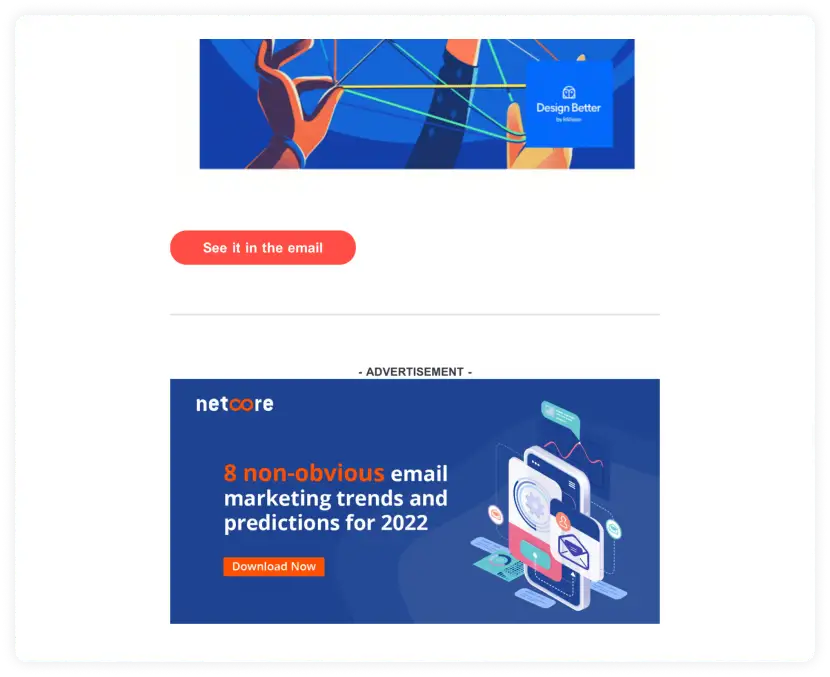
These ads have decent flexibility in sizing, and you can choose anything like 970×550, 970×250, 728×90, or 300×250 to best suit your requirements.
Tip: Use GIFs instead of static images or videos to capture reader attention and drive engagement without rendering issues in the email clients.
You can customize display ads to target audiences based on their activity on the browser or email. Companies use separate platforms like LiveIntent to place real-time advertising in email. So, when the email is opened, the reader will see a user-interest ad populated via HTML code.
• Native ads
Native ads are usually related to the email, making it easy to integrate them seamlessly into the email. In addition, these ads don't create any abrupt interruption when readers go through your email, thus not creating a bad reading experience.
These characteristics of the native ad can be seen in the below example, where the ad blends seamlessly with the email as it talks about the same topic as the email.
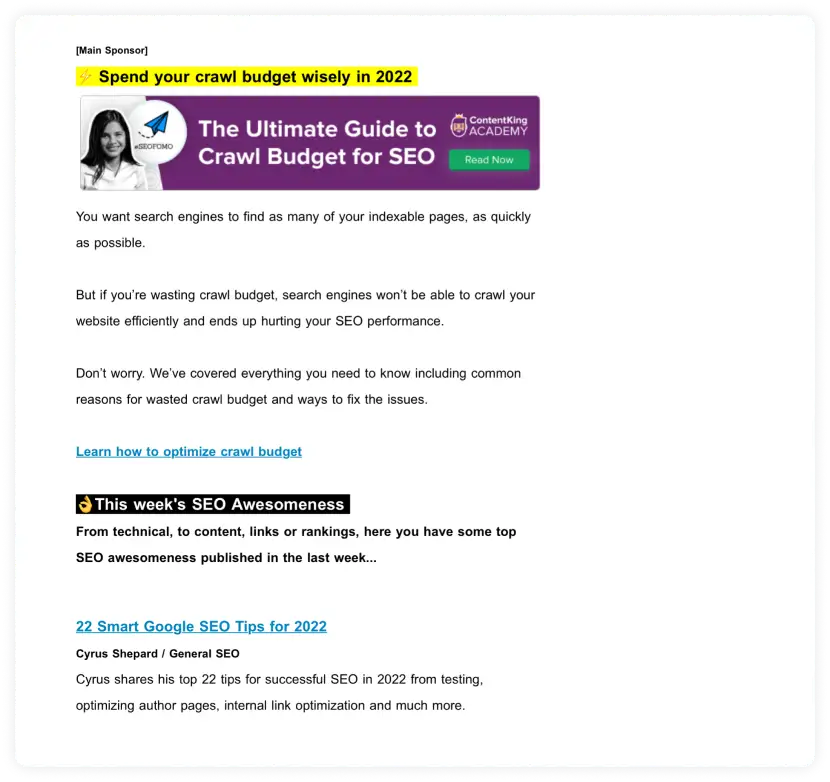
While these seamless ads might be better to advertise with quality content while looking native or natural to the email, they come with a few issues. Native advertising that looked "pure" journalism or normal content has often misled readers and created trust issues when they discover that what they're reading is a paid commercial.
As a result, native advertisements must be immediately distinguishable if companies want to preserve readership, customer trust, and loyalty. Even if the unit does not contain standard promotional advertising messaging, use language that implies that the advertising has been paid for, making it an advertising unit.
Overall, it should be so that a reader can differentiate between sponsored advertising and editorial content published by a publisher regardless of context.
• Sponsorships
You can do sponsorships through email in a few different ways. One way is by allowing a third party to sponsor the email in exchange for an advertisement or endorsement section in the email.
Here Zendesk Suite sponsored one of Product Hunt 's newsletters to get a dedicated section to endorse their product. This sponsorship ad allows Product Hunt Daily to profit from advertising while preserving control and trust with its readers. They achieve this by creating a native ad-like feel and keeping the ad design consistent with the normal content design and layout.
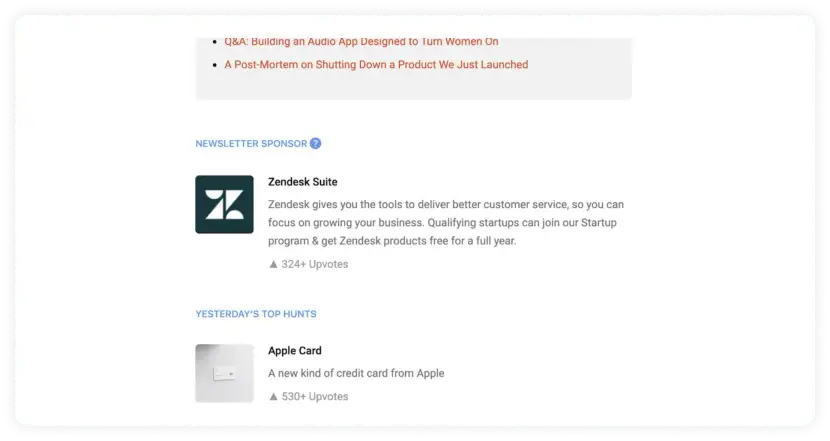
Related guide: How to become #1 Product on Product Hunt
• Affiliate or partnerships
The previously mentioned email ads are a one-time deal where you can pay to place ads once you are done. But, in terms of affiliate or partner, it's usually based on a mutually beneficial relationship between two brands, as in the example below.
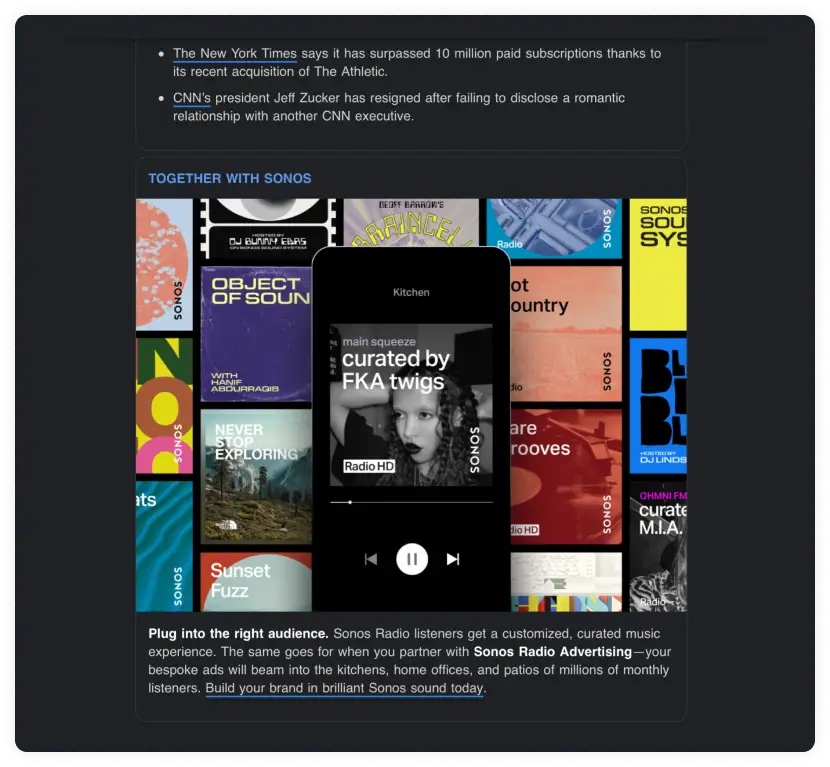
Paying them to send emails to their subscribers about your product or service can be straightforward. It could also be in exchange for access to your product or service. Sometimes people even create partnerships where they advertise in each other's emails.
2. Inbox advertising
Inbox advertising is the ads shown in the inbox of the reader's email client and is commonly seen at the top of the inbox, like in the example below.
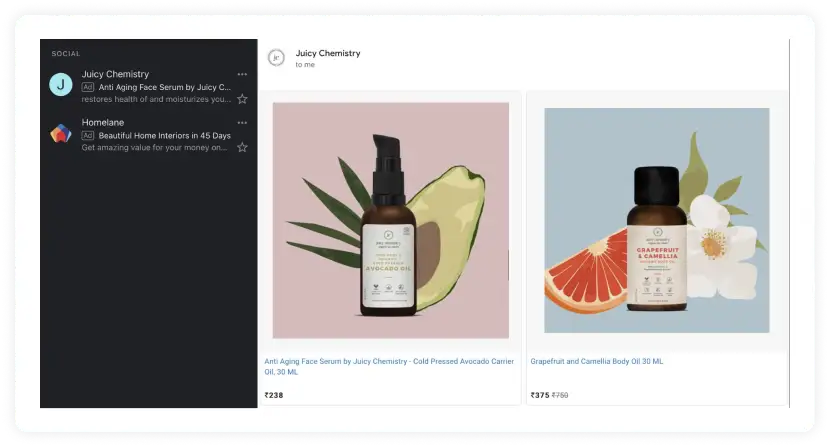
In this type of email advertising, people pay email clients like Gmail and create a campaign to place their ads in the inbox.
It works because when a reader logs into Gmail and clicks on the ad, it will expand into a fully immersive ad. And you will only have to pay Gmail if people click on your ad. Gmail ads are fully integrated with Adwords reporting making it easy to determine the success of your ads, site visits, and sales.
You can upload your email list and send ads to reconnect with your existing customers. Or find new customers by selecting characteristics your target audience has to find similar people.
How to start advertising through emails?
Now that you know everything about email advertising, let's talk about how you can advertise through emails.
In-email advertising
There are primarily two means you can use to add ads to your email campaign, and here they are:
- Using an email service provider (ESP)
In theory, you can use your email service provider to include advertisements in your emails. You could, for example, use an ESP to insert this if you only had one advertiser and they appeared in the same spot to everyone.
However, most email marketers want to maximize revenue by selling to many advertisers and enforcing intricate targeting techniques to improve ad relevance.
And, all of the above mentioned is not feasible using an ESP. So, we can say that it isn't well suited to conducting large-scale email advertising campaigns.
- Using email ad server
An email ad server is a tool that helps you manage different types of ads within your emails. It takes care of anything from Ad/promoted material, including direct-sold and programmatic ads, to house (internal) ads.
The ad server will pick the right ad in the email based on the advertisers' goals and your business requirements. You can use many email ad servers like Jeeng, Kevel, LiveIntent, and Passendo to set up your email ads.
Inbox advertising
We'll primarily focus on Gmail ads and the steps you have to take to set them up.
Create and sign in to your Google Adwords account.
Create a "Display Network only" campaign by selecting "No marketing objectives" and then "All features" as your campaign subtype.
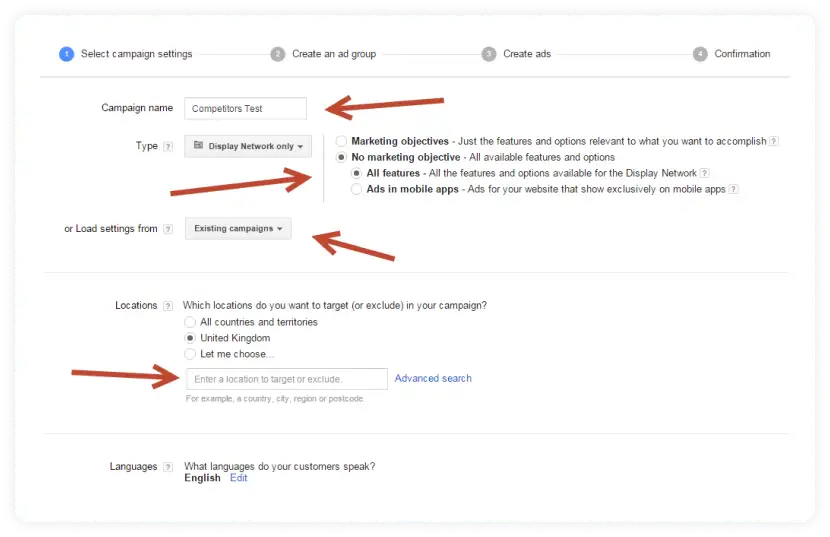
Fill in the rest of your campaign settings as you would for a normal display campaign.
When creating your ad group, select the option "Use a different targeting method," and for the targeting method, choose "Placements" from the drop-down.
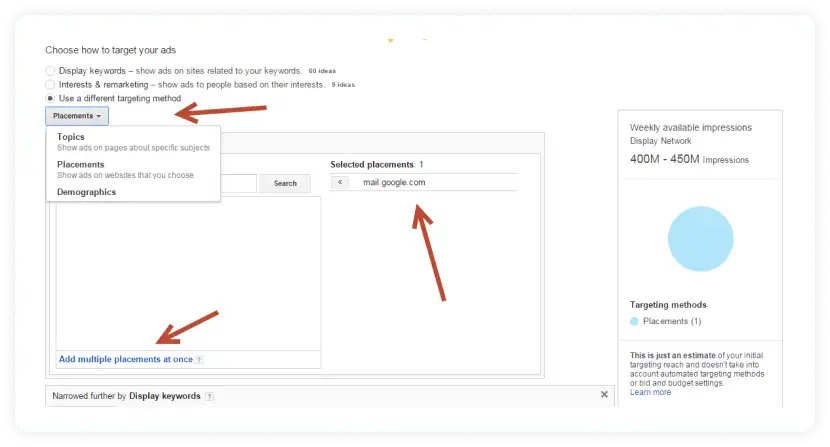
- Now search for Gmail and select "mail.google.com," then click "save and continue."
Note: It is crucial not to use in-market audience targeting, remarketing lists, dynamic search keywords, custom affinities, or placements other than Gmail inboxes since Gmail ads do not support these targeting methods.
Now back to the steps:
Since Gmail ads must be created using the Ad gallery, select "skip ad creation" after creating your Ad group.
Click the Ads tab. Click the red "+Ad" button, and select the Ad gallery from the drop-down menu. Click the Gmail ads image.
Select the ad template you would like to use. Choose "image," "single item," or "multiple items" templates.

Enter your ad name, display URL, and a landing page URL.
Upload all your campaign details like logo, subject line, description, and image.
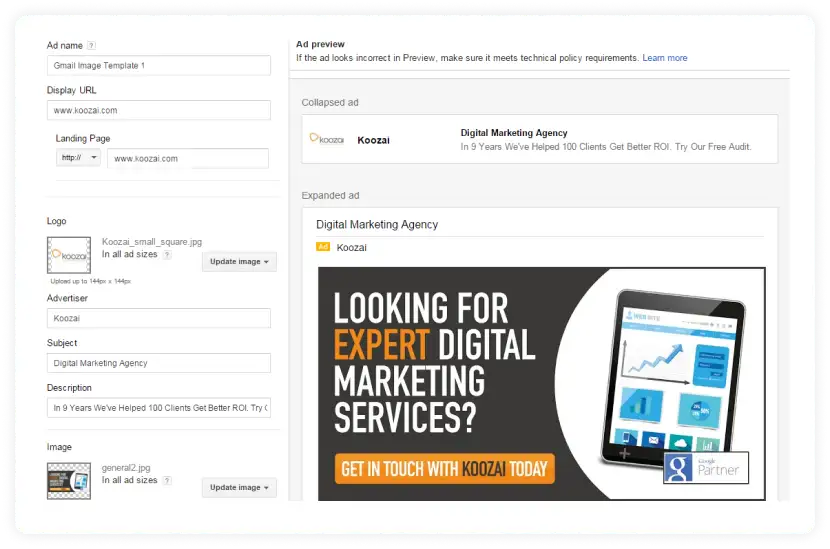
Note: Javascript, stylesheets, Flash, HTML5, audio, iFrames, and GIFs are not allowed.
Now, once everything looks good, check the ad preview. If it's good to go, click "save."
And that's all there is to creating Gmail ads.
Best practices to follow for email advertising
It's good to think of ads as an addition to your emails rather than the bulk of your email. Here are some best practices to follow when advertising in emails:
Advertise in the emails from companies in a similar niche as you so that your ad is relevant to readers.
Check the open rates, audience size, and other email metrics provided by the company hosting your ads to figure out if they have a good track record before you go ahead with the partnership.
Keep the email ad design minimal with the most crucial information like a header and CTA.
Add your brand logo to the email ad to help brand recognition.
When placing ads in your emails, be transparent and mention that it is an ad or that someone is paying for the content. It helps your customers trust you and the content you provide.
Before creating your ads, ensure you have a landing page to direct them towards rather than directing them to your website's homepage. A well-designed landing page with graphics and compelling CTAs will help you get more conversions.
Add a UTM to the link to help you track how much traffic you got from the ads.
Test the ad campaigns in the email before sending them to ensure that the images render well and the links work properly.
Don't go overboard and place too many ads in your emails, as it might confuse and annoy your readers.
Suppress your CRM data to target audiences outside your existing CRM database to help you increase your reach and get new customers.
Ask the company you are partnering with to send you a post-ad report to help you determine the success of your ad campaign.
Wrap up
And that's all there is to email advertising. We have covered everything from its pros and cons to best practices to help you use email advertising in a way that maximizes ROI.
Now all you have to do is start advertising through emails, as it is one of the most effective ways to broaden your brand's reach while maintaining tight control over your exposure, ideal audience, message environment, and campaign objectives.
If you want to try out other advertising avenues apart from email ads, check out our guide on display advertising.
What you should do next
Hey there, thanks for reading till the end. Here are 3 ways we can help you grow your business:
Talk to an email expert. Need someone to take your email marketing to the next level? Mailmodo's experts are here for you. Schedule a 30-minute email consultation. Don't worry; it's on the house. Book a meet here.
Send emails that bring higher conversions. Mailmodo is an ESP that helps you create and send app-like interactive emails with forms, carts, calendars, games, and other widgets for higher conversions. Get started for free.
Get smarter with our email resources. Explore all our knowledge base here and learn about email marketing, marketing strategies, best practices, growth hacks, case studies, templates, and more. Access guides here.


